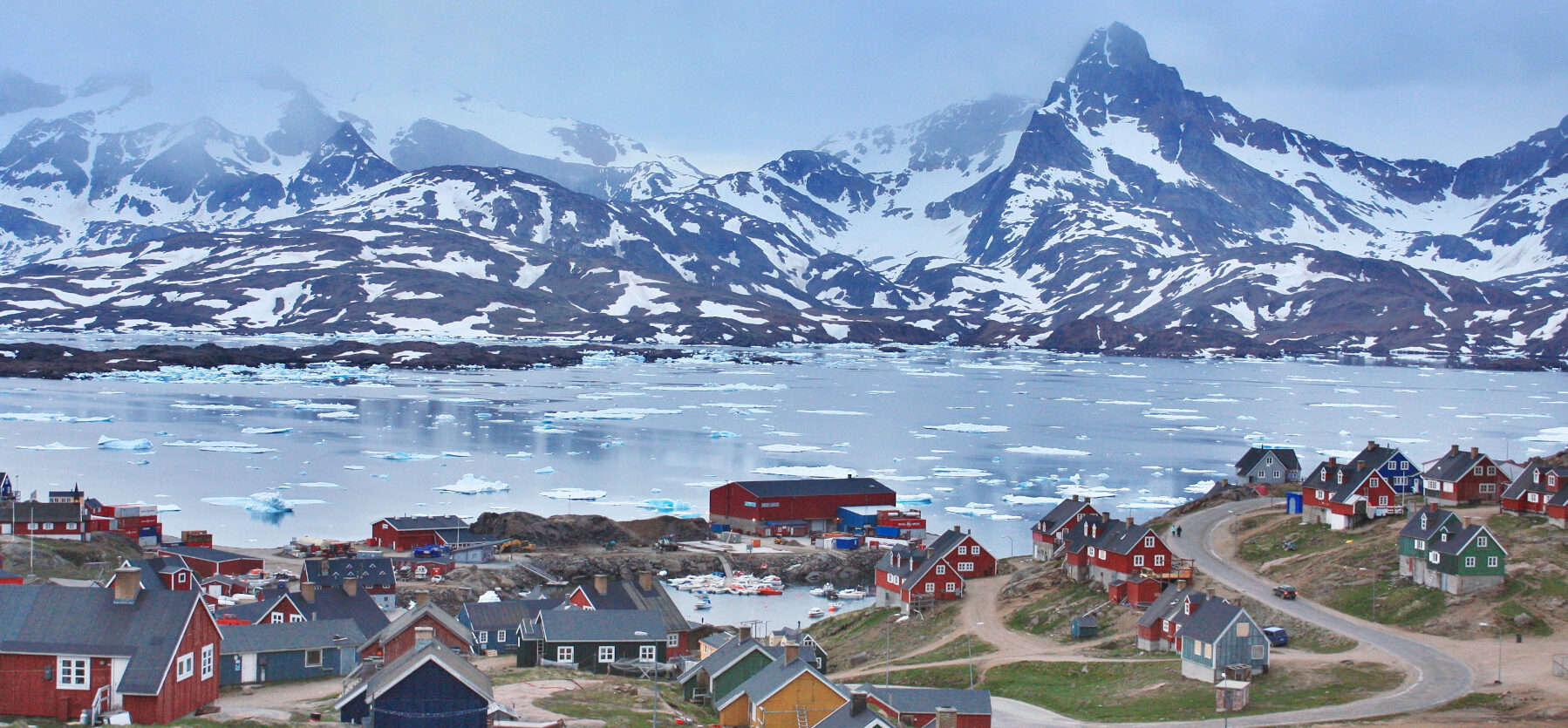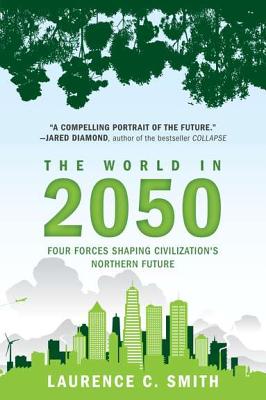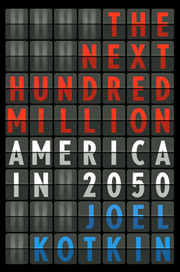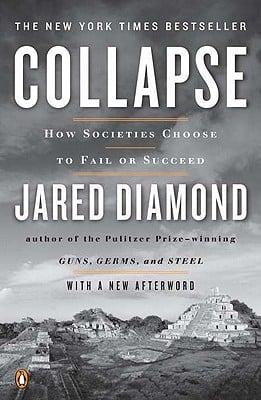Panama City, Panama. Several years ago, while teaching at Northern Virginia Community College, I ran out of geography courses to teach. Having taught the department staples many times, I scanned my apartment for ideas. Among the books on my dresser and night table, I noticed a pattern—the future—and “GEOG 395 Special Topics: Geography of the Future” was born. Loosely styled after the Great Books approach at my graduate alma mater, St. John’s, the course ran as a roundtable seminar based on close readings of three books: Laurence Smith’s The World in 2050: Four Forces Shaping Civilization’s Northern Future, Joel Kotkin’s The Next 100 Million: America in 2050, and Jared Diamond’s Collapse: How Societies Choose to Fail and Succeed.
All three books combine the authors’ wide-ranging analyses of trends with their extensive experiences in the field. For example, Smith is an expert in the geography of rivers and glaciers, and in 2012 he led a team of researchers that camped for six days in the middle of the mile-thick Greenland ice sheet, where they used GPS and a drone boat to track and measure the network of blue rivers and streams of meltwater that cut across and through the glacier each summer. The increased melting of the Greenland ice sheet is widely seen as a canary in the coal mine for future global warming, since temperatures are rising twice as fast in the Arctic as in the rest of the world.
Northern Futures
But in The World in 2050, Smith reveals another side to global warming: how people and countries stand to benefit from climate change in what he calls the “New North,” the northern quarter of the world’s latitudes (45° N latitude or higher). The eight countries here—the US, Canada, Iceland, Greenland (Denmark), Norway, Sweden, and Finland—control enormous territories and seas encircling the Arctic Ocean, which Smith calls a new “Northern Rim.” He predicts that warming temperatures in the future will enable new industries to grow in the New North and attract migrants and tourists. For example, the increased melting of sea ice in the Arctic Ocean will open up space for Trans-Arctic and Transpolar shipping routes to operate. Large commercial ships will be able to travel over the top of the world instead of around it, drastically cutting travel times and fuel costs. Prosperous “ports of the future” will emerge on the Arctic Ocean coasts of Northern Rim countries.
To be sure, Smith is not predicting the emergence of any major metropolises along the Arctic Ocean. He says it will require heavy recruiting to bring hardy souls and foreign workers to the Northern Rim, where winters are dark with subzero temperatures and the brief summers bring swarms of mosquitoes. But in the more hospitable southerly latitudes of the New North, he envisions more robust population growth:
[T]he New North today might be something like America in 1803, just after the Louisiana Purchase from France. . . Flying over the American West today, one still sees landscapes that are barren and sparsely populated, looking not much different now than they did then. Its towns and cities are relatively few, scattered across miles of empty desert. Yet its population is growing, its cities like Phoenix and Salt Lake and Las Vegas humming economic forces with cultural and political significance. This is how I imagine the coming human expansion in the New North. We’re not all going to move there, but it will become integrated into our world in some very important ways. . . . I imagine the high Arctic, in particular, will be rather like Nevada—a landscape nearly empty but with fast-growing towns fueled by a narrow range of industries. Its prime socioeconomic role in the twenty-first century will not be homestead haven but economic engine, shoveling gas, oil, minerals, and fish into the gaping global maw.
Around the Arctic Ocean coastline today, melting ice is uncovering valuable mineral deposits, including rare earth metals needed for electronics. Mining operations are threatening the ways of life of Arctic indigenous peoples, like the Inuit in Canada and Greenland, the Sámi in the Norway, Sweden, and Finland, and the Nenets and Chukchi in Russia. But profits from mining could also bring these groups newfound wealth and political power. For example, in Mackenzie Funk’s Windfall: The Booming Business of Global Warming, the chapter “Greenland rising: an independence movement heats up” gives a comical first-hand account of the scene as global mining and bottled water executives in suits show up at a community meeting hall in Greenland’s capital Nuuk to talk with seal- and whale-eating Inuit people about the large sums of money to be gained from selling the rights to export bottled water from their glaciers and mine rubies and pink sapphires heretofore buried under ice along their coasts. The prospect that these industries will bring increased economic self-sufficiency to Greenland has increased support for its movement to declare independence from Denmark.
Many other signs of changes great and small can be seen all around the New North today. In Greenland, new farming industries have been sprouting up among the Inuit, who are now raising potatoes, cabbage, strawberries, cattle, and sheep. In 2019-20, Canada’s highest rate of population growth was in the Inuit territory of Nunavut in the Arctic. Russia, the US, and China (which in 2018 labeled itself a “near-Arctic state”) are plotting strategies for expanded Arctic military operations. In the big picture, Smith predicts that as global warming makes tropical regions become more overheated, flooded, storm-wracked, overcrowded, and unlivable, it will also bring new people and industries to the New North.
The Future of the American Suburbs
The US population is projected to grow by about 100 million by 2050. In The Next Hundred Million, Kotkin explores who these new people will be demographically and where they will live. He says most of America’s next hundred million will be racial minorities, especially Hispanic and Asian, and the mixed-race population will grow rapidly. Pew Research Center predicts that whites will drop from 67% in 2005 to 47% in 2050, while Hispanics will double from 14% to 29% and Asians will jump from 5% to 9%. Hispanics pack a demographic one-two punch: They have the highest fertility rate among America’s major ethnic groups, and they make up some 50% of immigrants.
Kotkin says Americans in 2050 will still pursue the American Dream: owning a house with plenty of space to fill up with kids, in an area with good schools and a clean environment, owning their own businesses, and having enough expendable income to enjoy life. But he believes they aren’t likely to find the American Dream where past generations found it, in what he calls “superstar cities.” In March 2021, Kotkin wrote in UnHerd that the American Dream has left town “not only in New York, but San Francisco and Los Angeles, London and Paris. No longer cities of aspiration, they are increasingly defined by an almost feudal hierarchy: the rich live well, protected by private security and served by local coffee shops and trendy clubs.” He says these superstar cities—or “boutique cities”—have pursued development strategies that have abandoned the middle class and made them so prohibitively expensive that the wealthy elite who remain find themselves increasingly surrounded by low-income neighbors.
While superstar cities have largely become a no-go zone for the American Dream, Kotkin is optimistic about three other types of areas, which often overlap: 1) “cities of aspiration,” 2) an “archipelago of suburban villages,” and 3) The Heartland. Cities of aspiration, like Houston, Charlotte, Las Vegas, Spokane, Boise, and Nashville, are far more affordable than superstar cities and have far more growth potential. For example, whereas New York and Boston have seen over three centuries of growth and have entrenched building codes to preserve historic areas, and San Francisco restricts most building heights to 40 feet, Houston has no land use zoning codes at all. The resulting mishmash landscape isn’t always pretty, but Houston handed out 48,208 construction permits for single family homes in 2020, more than any other city in America. Kotkin says that while places like Baltimore, Detroit, and Cleveland pursued “cool city” strategies that flopped, cities of aspiration have excelled in providing “plain vanilla”—safe neighborhoods, job growth, good schools—which has made them magnets for migration.
Unlike many urbanists, Kotkin is a fan of the suburbs and criticizes the popular “smart growth” model, which combats suburban sprawl by making cities denser and more compact and walkable. He believes most people prefer a single-family home in the suburbs over a small downtown apartment. But he does acknowledge many problems of the suburbs, including auto-dependence, social isolation, and corelessness. So Kotkin advocates what he calls “smart sprawl”: making suburbs more like cities and towns by densifying them and adding new transit hubs focused on interconnecting suburbs rather than just feeding commuters into a larger city. He envisions “an archipelago of vibrant suburban town centers, villages, and urban cores.” In Kotkin’s dispersed, “multipolar” model, new suburban villages will be self-sufficient, not just bedroom communities. He says new suburban cores can be created in currently-underused spaces, such as by converting old shopping centers or dead farm towns into walkable community centers. “The future of America’s suburbs looks infinite,” he writes.
Kotkin’s faith in a better suburbia has many critics. For example, our class also read excerpts from two anti-suburbia classics: Andrés Duany’s classic Suburban Nation: The Rise of Sprawl and the Decline of the American Dream and James Kunstler’s The Geography of Nowhere: The Rise and Decline of America’s Man-Made Landscape, accompanied by Kunstler’s poignant and comical TED Talk The Ghastly Tragedy of the Suburbs. The pioneer of New Urbanism, Duany highlights America’s overuse of land use zoning codes, which he says are designed to make cars happy, not pedestrians. He says land use zoning codes, which form the DNA of the suburbs, have unnecessarily forced the basic functions of life far apart from each other, forcing automobile dependence, preventing quick access to basic necessities, and making street life often non-existent:
Once applied only to incompatible uses, [land use zoning] is now applied to every use. A typical contemporary zoning code has several dozen land use designations; not only is housing separated from industry but low-density housing is separated from medium-density housing, which is separated from high-density housing. Medical offices are separated from general offices, which are in turn separated from restaurants and shopping. . . The new American city has been likened to an unmade omelet: eggs, cheese, vegetables, and a pinch of salt, but each consumed in turn, raw.
Kunstler focuses more on the social consequences of the fragmented suburbs, Duany’s unmade omelets, which are marked by oceanic parking lots, cul-de-sacs, and unused token sidewalks that lead to nowhere. He says places built like this work against the physical integration necessary to form a community:
Community is not something you have, like pizza. Nor is it something you can buy. It’s a living organism based on a web of interdependencies—which is to say, a local economy. It expresses itself physically as connectedness, as buildings actively relating to each other, and to whatever public space exists, be it the street, or the courthouse or the village green.
These critiques of the suburbs parallel political philosopher Patrick Deneen’s central critique in Why Liberalism Failed. As Deneen puts it, “liberalism has failed precisely because liberalism has succeeded” in its aim of liberating us from each other. Social media have liberated us from the need to talk to real people face to face, and sprawling suburbs and the life of driving everywhere they necessitate have liberated us from the need to interact and engage with people on the street and our neighbors. In so doing, they have pushed us toward extreme individualism, loneliness, and isolation.
In different ways, both Duany’s tight New Urbanism and Kotkin’s loose suburban archipelagos help reintegrate American life and facilitate community. Kotkin believes that by tweaking the suburbs, we can make life there more social and multidimensional while keeping their spaciousness, privacy, and affordability. Duany’s architectural firm DPZ has designed dozens of dense, walkable new towns and community revitalization projects, such as Seaside, Florida, Reinvent Phoenix, and East End Richmond. They embody traditional principles of town planning practiced in the centuries before post-WW2 sprawl, when the American small town, centered on a Main Street, was an ideal admired around the world. Traditional towns or better suburbs? In a country as vast as the US, there is room for both.
Which region of America is best positioned to see the future growth of the sorts of cities of aspiration and suburban villages that Kotkin describes? The answer, he says, is the Heartland: the vast, flat expanse of 20 states between the Rockies and the Appalachians. Here, in places like Dallas, Fargo, Cincinnati, and Des Moines, Americans are finding what Kotkin calls a “Zone of Sanity,” where housing prices are far saner than on the coasts. Millennials as well as immigrants from places like India, Mexico, Liberia, Guatemala, Vietnam, the Philippines, and Myanmar are flocking to the “resurgent Heartland,” helping to reverse its population decline, expand its ethnic diversity, and give a sense of a future to once-dying towns.
The Heartland has long been dominated by making and doing industries—agriculture, energy, natural resources, and transport. And its geographic centrality will ensure that it will continue to be a prime location for anything involving distribution, such as food processing, wholesaling, and the onshoring of high-end manufacturing. But more and more IT and research companies are emerging in the Heartland. For example, Dell’s headquarters is in Round Rock, Texas, Microsoft has a campus in Fargo, and T-Mobile’s headquarters is in Overland Park, Kansas.
The long distances that often separate Heartland cities, and their distance from the ocean, have historically been an obstacle to growth and connectivity. But the internet and cheap air travel are changing that. And in 2021, the Federal Railroad Administration released a plan for high-speed rail linking twelve states of the Midwest. Kotkin wrote in a Spring 2021 American Affairs article that “A new era of individual empowerment, brought on by technology, places greater emphasis on quality of place, since people and companies have an expanded geography to choose from. Rather than focus on grandiosity or a sense of inevitability, cities need to heed to Aristotle’s admonition to offer their residents the promise of ‘living well’ in whatever urban form they choose.” If Kotkin is correct, a disproportionate number of America’s next hundred million will find that cities of aspiration and new suburban villages across the resurgent Heartland offer their best opportunities for living well.
The Future of Civilizations
Diamond’s book Collapse is a compilation of bracing case studies from around the world that serve as warnings about the ways civilizations can crumble. One of its many lessons is that unintended consequences can be deadly. For example, in the chapter “Malthus in Africa: Rwanda’s Genocide,” Diamond illustrates how the introduction of New World crops, modern medicines, and improved public health standards—without an accompanying modernization of agriculture—contributed to making Rwanda the most overpopulated country in Africa. Pressure on the land skyrocketed, and individual farm sizes shrank to a miniscule average of .07 acre in 1983, slightly larger than a tennis court. “The whole country looked like a garden and banana plantation,” Diamond’s friends reported in 1984. “Steep hills were being farmed right up to their crests. Even the most elementary measures that could have prevented soil erosion… were not being followed.” This brought famines and food shortages in the late 80s. Thus, Diamond concludes that the cause of the 1994 Rwandan Genocide was not just the “usual accounts” of inequalities and animosities among the Hutu and Tutsi tribes. It was also a Malthusian catastrophe in which people running out of food supply thinned out demand by eliminating 800,000 of their neighbors with guns and machetes.
I live in Panama and saw a different scene of scarcity and vigilantism on a recent trip to Nicaragua. It is a country of vast farmlands and beautiful volcanoes, lakes, and beaches that corrupt governments have made the second-poorest nation in the Western Hemisphere. Just after Christmas 2021, my intercity bus approaching the capital, Managua, had to pause in the highway as four people wielding pipes and pieces of wood chased a man and a woman out into eight lanes of traffic, swatting the man so that he crumpled on the pavement. A woman then threw a jagged foot-wide chunk of cement at him with two hands. He got up, bloodied, and they continued to chase him to the shoulder of the highway and gave him a few more shots before walking away. “Mátalo!” or “Kill him!” the passenger next to me yelled out the window. He said the man was a thief, and that thieves like that were a big problem. Citizens could not count on the police to protect their property, so these normal-looking middle aged people had taken protection into their own hands.
Diamond offers a “five-point framework” of major causes of societal collapse, two of which are particularly relevant here. One is the way in which a society responds to problems, which “depends on its political, economic, and social institutions and on its cultural values.” In a time when some people have suggested defunding or eliminating the social institution of policing, as if this will reduce brutality, these cases from Rwanda and Nicaragua show that in the geography of the future, there will always be policing. It’s just a question of who will do it: middle-aged shopkeepers wielding steel pipes, banana farmers swinging machetes, or trained professionals, imperfect as they may be. Removing the official police will only increase brutality by unofficial police.
Another of Diamond’s five points that help understand the roots of societal collapse is “the damage that people inadvertently inflict on their environment.” His chapter “China, Lurching Giant” shows just that: how the Chinese Communist Party’s no-brakes approach to economic development has led it to repeatedly degrade its own environment, then lurch back in the opposite direction with major policy changes to try to fix the damage. China is the world’s biggest polluter yet also the biggest investor in green technologies. It burns more coal than the rest of the world combined, yet it has led the world in reducing the costs of solar panels, wind turbines, and electric vehicles. Diamond also shows how China is now exporting the unintended consequences of its hyper-speed development: Having polluted its own air and water and razed its own forests, it has become the world leader in illegal fish and timber imports, and it wafts transboundary air pollution across the Pacific to places like South Korea, Japan, and California. “Like the rest of the world, China is lurching between accelerating environmental damage and accelerating environmental protection,” writes Diamond. “China’s large population and large growing economy, and its current and historic centralization, mean that China’s lurches involve more momentum than those of any other country. The outcome will affect not just China, but the whole world as well.”
The Post-COVID Future
All three of these books were written before the COVID era, which has corroborated many of the authors’ predictions. The prioritization of social distancing supports Kotkin’s prediction that Americans will increasingly prefer spacious suburbs to dense cities—as well as Smith’s prediction that more people will migrate to the remote New North as it grows warmer. The lower densities of the suburbs and the Heartland will make them even more so a Zone of Sanity—not just in Kotkin’s original sense of saner home prices, but in the Latin sense of sanus, meaning health. COVID gave Diamond’s “lurching giant” metaphor a whole new range of applications: Chinas’ Communist Party rapidly accelerated virus research in the past decade, without enforcing global biosafety standards, then handled the outbreak of COVID recklessly. It later lurched into massive policies trying to fix the problem, including “COVID diplomacy”—sending out vaccines and teams of doctors to assist other countries—and now a new “zero-COVID” strategy of strict lockdowns and immediate mass testing.
Together, all the issues discussed above constitute only a fraction of those explored in these three books about the future. Each author is a rare combination of astute scholar and entertaining storyteller who, with a geographer’s eye, connects facts and cases from across the map to identify hidden trends that will shape the future. At a time when ideologies and slogans often pull us away from the difficult task of finding realistic solutions and building a world together, the approach of these authors reveals the necessity of digging deep to confront the facts as they are and recognizing the complexity of challenging issues. While these books illuminate a vast array of natural and social forces at work, they also show how the geography of the future will largely be what we make of it.
Image Credit. The photo depicts Tasiilaq, the largest town on the eastern coast of Greenland. With a 2020 population of 1,985, its population has grown by over 37% since 1990.






2 comments
David Naas
The melting ice will expose new minerals which we can exploit, Hurrah! And we can fill up the spaces overlooked by the latte-sipping elites, Hurrah! Unlimited growth in our lifetimes, Hurrah.
And afterwards, perhaps we can exploit the asteroids for our mineral needs, Hurrah.
Except – – the only organism which needs unlimited expansion as much as our 21st century economy is — a cancer cell, Hurrah!
Don’t mind me, just an old guy yelling at a cloud.
Brian D Miller
The idea that Greenland, without topsoil, is going to be a farming mecca, I find problematic.
However, to Brian:
As someone who farms for a living, I take note of the changes in both the weather and the climate. Any conversation with someone who has farmed in our valley longer than me (and I’m 59) brings to light that the climate has changed…significantly. Do you oppose, Brian, the idea of climate change simply on political grounds? Or, is there some other practical assessment you have made that sheds further light. Please enlighten.
Comments are closed.